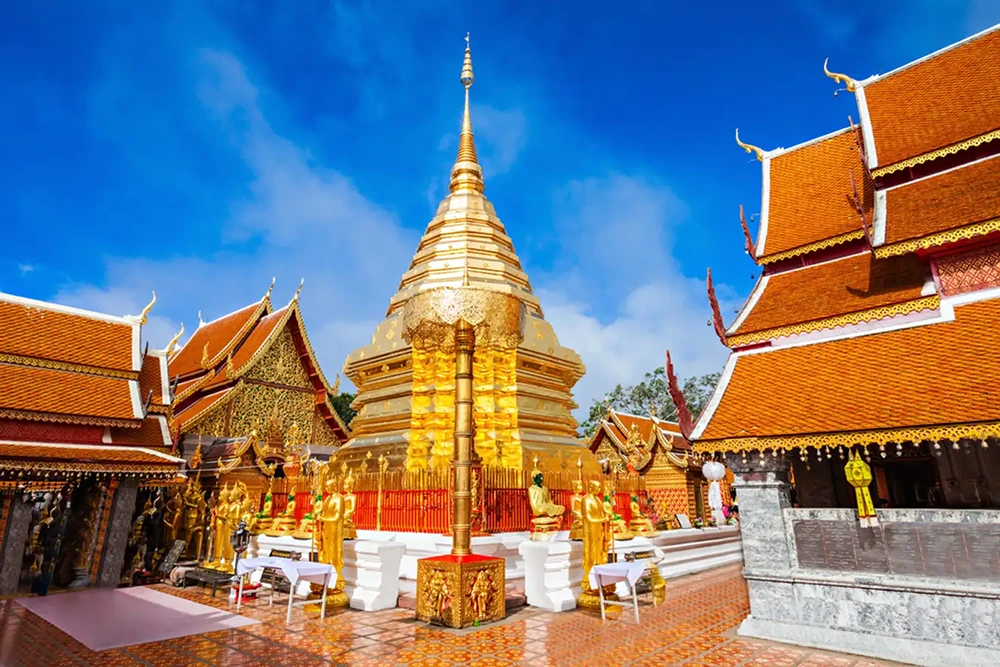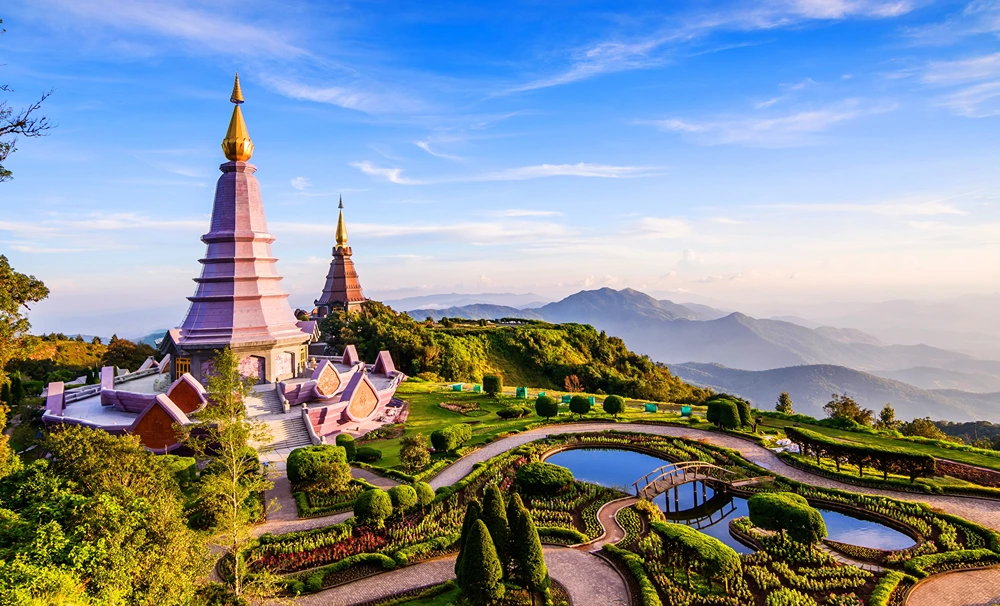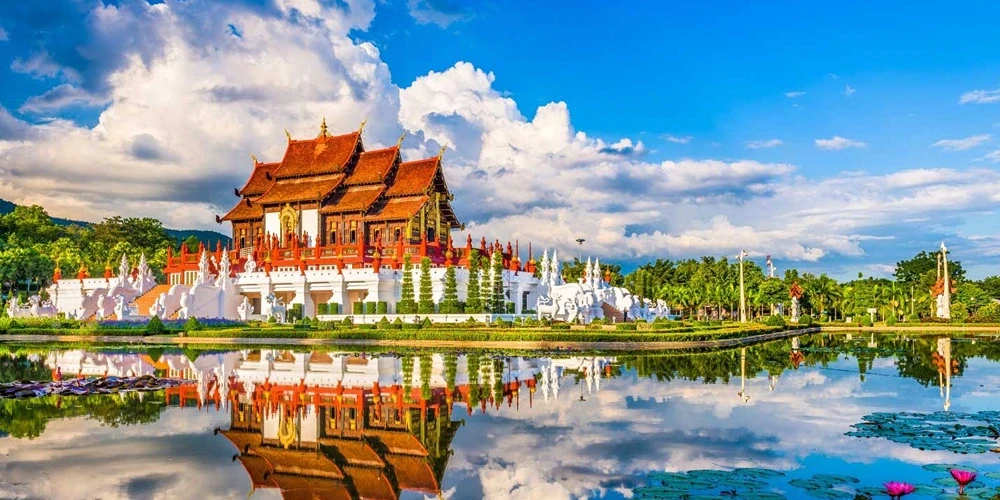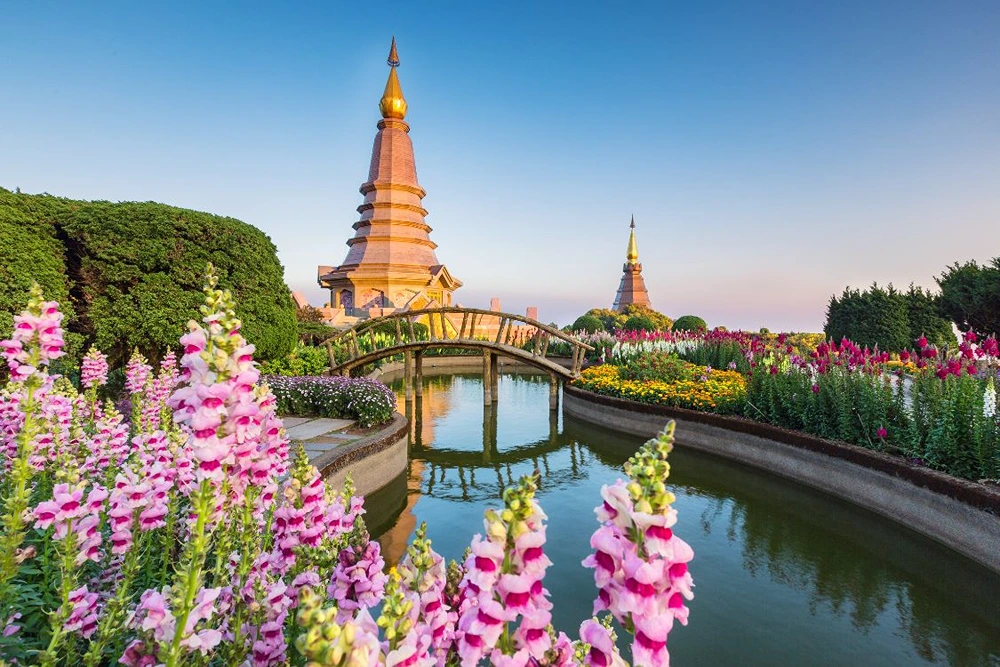Key highlights of Chiang Mai include:
- Hundreds of ornate temples showcasing Lanna architecture
- Lush mountainous landscapes perfect for trekking and adventure
- Vibrant night markets offering local crafts and delicious street food
- Rich cultural experiences including traditional festivals and handicrafts
- Proximity to hill tribe villages and elephant sanctuaries
Travel Resources
- Cheapest Flights to Chiang Mai: Find affordable flights to Chiang Mai with our flight search tool. Start planning your trip to this enchanting city.
- Insure Your Trip: Ensure peace of mind during your travels with the right travel insurance coverage.
- Rent a Car in Chiang Mai: Rent a car to explore Chiang Mai and its surrounding areas independently.
- Book Your Tours: Discover the best of Chiang Mai with our curated selection of tours and activities.

Some History First
Chiang Mai’s history is deeply rooted in the ancient Lanna Kingdom:
- Founded in 1296 by King Mengrai as the capital of the Lanna Kingdom
- Strategically located on trading routes between southern China and Burmese ports
- Lanna culture flourished for several centuries, developing its own unique art, architecture, and cuisine
- Fell under Burmese rule in 1558 for over 200 years
- Became part of Siam (Thailand) in 1774, retaining much of its cultural distinctiveness
Key historical sites include:
- Wat Phra That Doi Suthep: Founded in 1383, it’s the city’s most famous temple
- Wat Chedi Luang: Home to the “City Pillar” and once housed the Emerald Buddha
- Old City Walls and Gates: Remnants of the old fortified city
Chiang Mai Today
Modern Chiang Mai seamlessly blends ancient traditions with contemporary life:
- Population: Approximately 1.2 million in the metropolitan area
- Economy: Major center for handicrafts, tourism, and education in Northern Thailand
- Culture: Preserves Lanna traditions while embracing modern Thai and global influences
- Technology: Growing hub for digital nomads and tech startups
Notable aspects of contemporary Chiang Mai:
- Thriving arts scene with numerous galleries and craft workshops
- Popular destination for wellness and meditation retreats
- Educational center with several universities and language schools
- Growing cafe culture with a mix of traditional and modern coffee shops
Is Chiang Mai Safe?
Chiang Mai is generally considered safe for tourists, but as with any destination, it’s important to exercise common sense:
- Petty crime: Be aware of pickpocketing in crowded markets and tourist areas
- Traffic: Exercise caution when crossing streets, as traffic can be chaotic
- Scams: Be wary of overly friendly strangers offering unsolicited help or deals
Safety tips:
- Keep valuables secure and be aware of your surroundings
- Use reputable transportation services
- Drink bottled water and be cautious with street food hygiene
- Respect local customs and dress modestly when visiting temples
Where is Chiang Mai?
Chiang Mai is strategically located in northern Thailand:
- Coordinates: 18.7883° N, 98.9853° E
- Region: Northern Thailand, in the Chiang Mai Province
- Terrain: Surrounded by mountains and lush countryside
- Elevation: Approximately 310 meters (1,017 ft) above sea level
Neighboring provinces include:
- Chiang Rai
- Lampang
- Lamphun
- Mae Hong Son
Latest Articles
From The Area
What is the Best Time to Visit Chiang Mai?
- November to February (Cool Season): The most popular time to visit
- Comfortable temperatures (average 14-28°C / 57-82°F)
- Low humidity and minimal rainfall
- Ideal for sightseeing and outdoor activities
- Popular festivals like Loy Krathong and Yi Peng
- March to May (Hot Season):
- Very hot and dry (average 23-36°C / 73-97°F)
- Songkran (Thai New Year) festival in April
- Smoky conditions due to agricultural burning
- June to October (Rainy Season):
- Frequent rainfall, but usually short showers
- Lush green landscapes
- Fewer tourists and lower prices
How to Get to Chiang Mai & Around
Getting to Chiang Mai:
- By Air:
- Chiang Mai International Airport (CNX): Well-connected to major cities in Asia
- Domestic flights from Bangkok, Phuket, and other Thai cities
- By Train: Overnight trains from Bangkok (12-15 hours)
- By Bus: Long-distance buses from Bangkok and other major cities
Getting Around Chiang Mai:
- Songthaews: Red shared taxis, the most common form of public transport
- Tuk-tuks: Good for short trips within the city
- Bicycles: Many guesthouses and shops offer bicycle rentals
- Motorbikes: Popular for exploring, but exercise caution
- Grab: Ride-hailing app available in Chiang Mai
- Taxis: Less common but available, ensure they use the meter
Things to Do in Chiang Mai
Discover the top attractions and activities in Chiang Mai:
Cultural Attractions:
- Wat Phra That Doi Suthep: Iconic temple offering panoramic views of the city
- Old City Temples: Wat Chedi Luang, Wat Phra Singh, Wat Suan Dok
- Baan Kang Wat Artist Village: Community of local artists and craftspeople
Nature and Adventure:
- Doi Inthanon National Park: Home to Thailand's highest peak
- Elephant Nature Park: Ethical elephant sanctuary
- Zip-lining: Several operators offer canopy tours in the jungle
Markets and Shopping:
- Sunday Walking Street: Vibrant night market in the Old City
- Night Bazaar: Daily market offering local goods and street food
- Warorot Market: Traditional market popular with locals
Wellness and Relaxation:
- Thai Massage: Numerous traditional and modern spas available
- Meditation Retreats: Many temples offer courses for beginners
- Yoga Classes: Available at studios throughout the city
Cooking and Food Experiences:
- Cooking Classes: Learn to make traditional Thai and Lanna dishes
- Street Food Tours: Guided tours of the best local eats
- Organic Farms: Visit and learn about sustainable agriculture
Where To Stay In Chiang Mai
Chiang Mai offers a wide range of accommodation options:
Old City:
- Budget: Julie Guesthouse, Deejai Backpackers
- Mid-range: Tamarind Village, Rachamankha
- Luxury: Anantara Chiang Mai Resort, 137 Pillars House
Nimman Area:
- Budget: Hug Nimman Hotel, Yesterday Hotel
- Mid-range: Eastin Tan Hotel, Akyra Manor Chiang Mai
- Luxury: U Nimman Chiang Mai, The Chiang Mai Old Town
Riverside:
- Mid-range: Ping Nakara Boutique Hotel & Spa, Rarin Jinda Wellness Spa Resort
- Luxury: The Dhara Dhevi Chiang Mai, Four Seasons Resort Chiang Mai
Tips for choosing accommodation:
- The Old City is ideal for first-time visitors and culture enthusiasts
- Nimman area is popular with digital nomads and offers trendy cafes and shops
- Consider staying near the Ping River for a more relaxed atmosphere

What To Eat In Chiang Mai
Chiang Mai is a food lover’s paradise, offering unique northern Thai cuisine:
Must-try dishes:
- Khao Soi: Curry noodle soup, Chiang Mai’s signature dish
- Sai Oua: Spicy northern Thai sausage
- Khanom Jeen Nam Ngiaw: Rice noodles with spicy tomato-based pork sauce
- Khao Kha Moo: Stewed pork leg over rice
- Miang Kham: Leaf-wrapped bite-sized snack
Where to eat:
- Street Food: Try Chang Phueak Gate (North Gate) for the famous “Cowboy Hat Lady’s” khao kha moo
- Markets: Warorot Market or Ton Lamyai Market for local specialties
- Restaurants: Huen Phen for traditional northern Thai cuisine, or David’s Kitchen for fine dining
Food safety tips:
- Choose busy stalls with high turnover
- Ensure meat is thoroughly cooked
- Be cautious with raw vegetables and fruits you can’t peel
Entry & Exit Requirements
Visa requirements for entering Thailand apply to Chiang Mai:
- Many nationalities can enter visa-free for 30 days
- Some may need to obtain a visa on arrival
- For longer stays, apply for a tourist visa at a Thai embassy before travel
Important documents:
- Passport valid for at least 6 months beyond your planned stay
- Proof of onward travel
- Proof of sufficient funds (20,000 baht per person or 40,000 baht per family)
Departure:
- Departure tax is typically included in your airline ticket
- Keep your departure card (given upon arrival) for presentation at exit
Always check the latest requirements with the Thai embassy or consulate in your country before travel.
What To Pack For Your Trip
When packing for Chiang Mai, consider the tropical climate and cultural norms:
Essentials:
- Lightweight, breathable clothing
- Comfortable walking shoes
- Modest attire for temple visits (covered shoulders and knees)
- Light jacket or sweater for cool evenings (November-February)
- Rain jacket or umbrella (especially June-October)
- Sunscreen and insect repellent
- Reusable water bottle
- Power adapter (Thailand uses 220V, 50Hz with Type A, B, and C plugs)
Additional items:
- Hand sanitizer and wet wipes
- Medication and a basic first-aid kit
- Photocopies of important documents
- Cash and credit cards (inform your bank of your travel plans)
- Day pack for excursions
Tip: Chiang Mai has plenty of markets and shops, so you can always buy clothing and other essentials locally if needed.
Remember to respect local customs and dress codes, especially when visiting temples or rural areas. With proper preparation, your trip to Chiang Mai will be comfortable, enriching, and memorable.
FAQs
Chiang Mai is family-friendly, with plenty of activities and attractions suitable for all ages.
Don’t miss Wat Phra That Doi Suthep, Wat Chedi Luang, and Wat Phra Singh.
Yes, there are ethical elephant sanctuaries where you can interact with rescued elephants responsibly.



